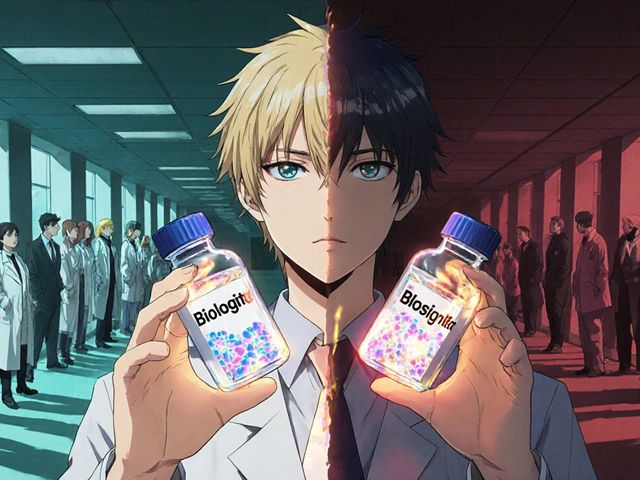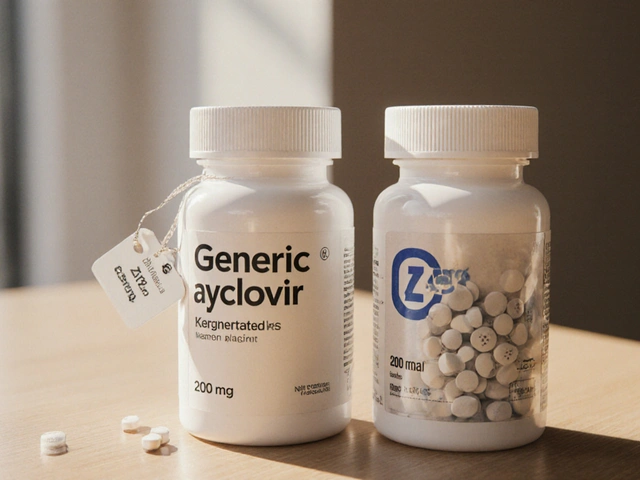AUD Medication Matcher
Select patient considerations:
Acamprosate is a brain‑chemical modulator approved to help maintain abstinence in people with Alcohol Use Disorder (AUD). Marketed as Acamprol, it works by stabilising glutamate activity and supporting GABA function, reducing post‑withdrawal cravings.
Why compare Acamprosate with other options?
When a clinician prescribes a medication for AUD, the decision hinges on efficacy, safety, patient preference, and co‑existing conditions. While Acamprosate shines in keeping people sober after detox, other drugs such as Naltrexone an opioid‑receptor antagonist that blunts the rewarding effects of alcohol or Disulfiram a deterrent that causes unpleasant reactions if alcohol is consumed can be better for certain relapse patterns.
How Acamprosate works - the science in plain terms
After heavy drinking, the brain’s excitatory glutamate system becomes overactive while inhibitory GABA signaling weakens. Acamprosate, a calcium‑salt of N‑acetyl‑homotaurine, restores balance by partially blocking NMDA‑type glutamate receptors and enhancing GABA‑A activity. Clinical trials (e.g., a 2022 multicenter study with 1,000 participants) showed a 30% higher abstinence rate at 12weeks compared with placebo.
Key alternatives and what makes them different
- Naltrexone Blocks opioid receptors, reducing the pleasure derived from alcohol - ideal for patients who binge drink or have a strong craving pattern.
- Disulfiram Inhibits aldehyde dehydrogenase, causing flushing, nausea, and palpitations if alcohol is ingested - acts as a deterrent, best for highly motivated individuals who can avoid accidental exposure.
- Topiramate An antiepileptic that reduces dopamine release and modulates GABA receptors - shows promise for reducing heavy‑drinking days but carries cognitive side‑effects.
- Gabapentin Originally for neuropathic pain, it dampens excitatory neurotransmission and eases withdrawal anxiety - frequently prescribed off‑label for AUD with comorbid sleep issues.
- Baclofen A GABA‑B agonist that reduces craving by calming the central nervous system - useful for patients with liver impairment because it’s renally cleared.
Head‑to‑head comparison
| Attribute | Acamprosate (Acamprol) | Naltrexone | Disulfiram | Topiramate | Gabapentin | Baclofen |
|---|---|---|---|---|---|---|
| Primary Mechanism | Glutamate‑GABA modulation | Opioid‑receptor antagonism | Aldehyde dehydrogenase inhibition | GABA‑enhancement & dopamine reduction | Voltage‑gated calcium channel inhibition | GABA‑B agonism |
| Typical Dose | 666mg three times daily | 50mg once daily | 250-500mg daily | 25-100mg twice daily | 300mg three times daily | 5-10mg three times daily |
| Abstinence Benefit (12wk) | 30% increase vs placebo | 20-25% increase | Variable; depends on adherence | ≈18% reduction in heavy‑drinking days | ≈15% reduction in cravings | ≈22% improvement in abstinence |
| Key Side‑effects | Diarrhea, abdominal cramping | Nausea, hepatotoxicity (rare) | Flushing, headache, metallic taste | Cognitive slowing, paresthesia | Somnolence, dizziness | Muscle weakness, drowsiness |
| Renal Considerations | Dose reduced if eGFR <30mL/min | No adjustment needed | No adjustment needed | Caution in severe renal disease | Use with caution if impaired | Safe; renal clearance |
| Alcohol Interaction | None; safe with abstinence | Can be taken while drinking (reduces reward) | Triggers severe reaction if alcohol consumed | May reduce drinking intensity | Alleviates withdrawal anxiety | Reduces cravings without aversive reaction |

Choosing the right medication for a patient
Think of the decision as a match‑making exercise. Ask these three questions:
- What is the predominant drinking pattern? Binge drinking & heavy cravings point to Naltrexone or Acamprosate, while sporadic drinking with a fear of relapse fits Disulfiram.
- Are there liver or kidney concerns? Acamprosate and Baclofen are safer for modest liver disease; baclofen’s renal clearance makes it a go‑to for kidney issues.
- Is the patient motivated to avoid any “taste‑of‑alcohol” trigger? If yes, Disulfiram works as a strong psychological deterrent.
In practice, many clinicians start with Acamprosate because it has a gentle side‑effect profile and does not require liver monitoring. If cravings persist, they may add or switch to Naltrexone.
Side‑effect profiles - what to watch for
Acamprosate’s most common complaint is gastrointestinal upset. A simple mitigation strategy is to split the 666mg dose into three 222mg tablets taken with meals. For Naltrexone, monitor liver enzymes at baseline and after three months, especially in patients with hepatitis C. Disulfiram demands strict education: patients must understand the severe reaction (hypotension, tachycardia) that can be life‑threatening if they slip.
Topiramate can cause word‑finding difficulties; clinicians often start at 25mg nightly and titrate slowly. Gabapentin’s dizziness is usually transient, but dose‑adjust in renal impairment. Baclofen may cause muscle weakness, so physical therapy is advisable for older adults.
Practical tips for clinicians and patients
- Start Acamprosate only after detox is complete; it does not prevent withdrawal.
- Combine medication with psychosocial support - CBT or mutual‑help groups raise success rates by ~15%.
- Use a medication‑adherence app; daily dosing (Acamprosate) benefits from reminders.
- Check renal function (eGFR) before prescribing Acamprosate or Baclofen; adjust dose if <30mL/min.
- Educate patients on the “no‑alcohol‑while‑on‑medication” rule for all AUD drugs to avoid confusing signals.
Related concepts worth exploring
If you found this comparison useful, you may also want to read about Alcohol Use Disorder (AUD) diagnostic criteria, behavioral therapies for relapse prevention, and the emerging role of Genetic testing for personalized AUD medication selection. These topics sit one level up (broader) in the AUD treatment knowledge hierarchy, while deep‑dives into each drug’s pharmacogenomics sit a level down (narrower).
Frequently Asked Questions
Can Acamprosate be taken while drinking?
Acamprosate is intended for use after complete detox. Drinking while on the medication does not improve outcomes and can mask cravings, so clinicians advise total abstinence during treatment.
How long should a patient stay on Acamprosate?
Guidelines suggest a minimum of three months, extending to 6‑12 months for individuals with high relapse risk. Continued use is safe as long as renal function remains adequate.
Is Acamprosate safe for people with liver disease?
Yes. Unlike Naltrexone, Acamprosate is not metabolised by the liver; it is excreted unchanged by the kidneys, making it a preferred option for mild‑to‑moderate hepatic impairment.
What are the main reasons patients stop taking Acamprosate?
The most common cause is gastrointestinal side‑effects leading to non‑adherence. Switching to a once‑daily formulation (now available in some markets) or taking the drug with food often resolves the issue.
How does Acamprosate compare cost‑wise to Naltrexone?
In the United States, a 30‑day supply of Acamprosate (generic) averages $120-$150, while generic Naltrexone is about $90-$110. Insurance coverage varies, so checking formularies is essential.
Can Acamprosate be combined with other AUD medications?
Yes, clinicians sometimes use a “dual‑therapy” approach, pairing Acamprosate with Naltrexone to target both craving reduction and reward blockade. Monitoring for additive side‑effects is advised.








Natalie Sofer
September 25, 2025 AT 23:49i just wanted to say thank you for laying this out so clearly. as someone who’s watched a loved one struggle with AUD, it’s rare to see meds explained without sounding like a drug company pamphlet. the table alone saved me hours of googling.
also, minor typo: ‘aldehyde dehydrogenase’ is misspelled as ‘aldehdye’ in the disulfiram line. not a big deal but thought i’d mention it since accuracy matters here.
Tiffany Fox
September 26, 2025 AT 17:00gabapentin changed my life. i was on acamprosate for 3 months, barely slept, cravings still hit like a truck. switched to gabapentin at 900mg at night-slept through the night for the first time in years. no more 3am vodka runs.
side effects? yeah, i’m a sleepy zombie in the morning. but i’d rather be tired than dead.
Rohini Paul
September 28, 2025 AT 14:34so acamprosate works better than naltrexone for abstinence but naltrexone’s better for bingers? that’s wild. i always thought the ‘block the high’ approach would win every time. turns out the brain’s weird. also why is baclofen not FDA approved for this? it’s everywhere in europe.
also, topiramate gave me brain fog so bad i forgot my own birthday. not worth it.
Sean Goss
September 29, 2025 AT 06:44the 30% abstinence stat is misleading. it’s relative risk increase not absolute. placebo had 40% abstinence so acamprosate pushed it to 52%. that’s not a miracle. also why no data on long-term relapse beyond 12 weeks? this feels like pharma marketing dressed as science. and why is disulfiram listed as ‘variable’? because it only works if you’re scared of vomiting your own organs
Courtney Mintenko
September 30, 2025 AT 07:36we’re all just chemically compromised monkeys trying to outrun our own neurochemistry
the real question isn’t which pill works-it’s why we need pills at all. society built a system where alcohol is the default coping mechanism and then acts shocked when people break
maybe we should fix the world instead of just patching the brain
Orion Rentals
September 30, 2025 AT 18:21Thank you for raising the point about societal context-it’s an essential perspective often overlooked in clinical discussions. While pharmacological interventions are vital for individual recovery, systemic factors such as access to mental health care, socioeconomic stressors, and cultural normalization of alcohol use significantly influence treatment outcomes. A 2023 meta-analysis in JAMA Psychiatry noted that patients in communities with robust peer support networks had a 40% higher sustained abstinence rate regardless of medication type. This suggests that medication should be viewed as a component of a broader biopsychosocial model, not a standalone solution. Additionally, the underutilization of baclofen in the U.S. is not merely regulatory-it reflects historical bias against GABAergic agents in addiction medicine, despite robust European data. We must advocate for evidence-based prescribing that transcends pharmaceutical marketing cycles and prioritizes patient-centered outcomes.